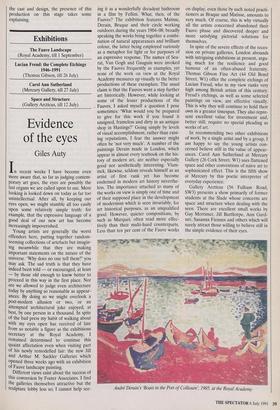Exhibitions
The Fauve Landscape (Royal Academy, till 1 September) Lucian Freud: the Complete Etchings 1946-1991 (Thomas Gibson, till 26 July) Carol Ann Sutherland (Mercury Gallery, till 27 July) Space and Structure (Gallery Arcticus, till 12 July)
Evidence of the eyes
Giles Auty
In recent weeks I have become even more aware that, so far as judging contem- porary art goes, the eyes are possibly the last organs we are called upon to use. Mere looking is looked down on today as far too unintellectual. After all, by keeping our eyes open, we might stumble all too easily upon some relatively simple truth: for example, that the expressive language of a good deal of our new art has become increasingly impoverished.
Young artists are generally the worst offenders here, putting together random- seeming collections of artefacts but imagin- ing meanwhile that they are making Important statements on the nature of the universe. 'Why does no one tell them?' you may ask. The sad truth is that they have Indeed been told — or encouraged, at least — by those old enough to know better to proceed in this way in the first place. Nor are we allowed to judge even architecture today by anything so reasonable as appear- ances. By doing so we might overlook a post-modern allusion or two, or an attempted architectural joke enjoyed, at best, by one person in a thousand. In spite of the bad press my habit of walking about with my eyes open has received of late from so notable a figure as the exhibitions secretary at the Royal Academy, I remained determined to continue this quaint affectation even when visiting part of his newly remodelled lair: the new Jill and Arthur M. Sackler Galleries which opened three weeks ago with an exhibition of Fauve landscape painting.
Different views exist about the success of this conversion by Foster Associates. I find the galleries themselves attractive but the sculpture lobby less so; I cannot help see-
ing it as a wonderfully decadent bathroom in a film by Fellini. What, then, of the Fauves? The exhibition features Matisse, Derain, Braque and their circle working outdoors during the years 1904-08; broadly speaking the works bring together a combi- nation of natural appearances and brilliant colour, the latter being employed variously as a metaphor for light or for purposes of an expressive response. The names of Seu- rat, Van Gogh and Gauguin were invoked by the Fauves frequently as examples, yet none of the work on view at the Royal Academy measures up visually to the better productions of these exemplars. The usual claim is that the Fauves went a step further art historically. However, while looking at some of the lesser productions of the Fauves, I asked myself a question I pose sometimes: 'What would you be prepared to give for this work if you found it unsigned, frameless and dirty in an antique shop in Hastings?' Going simply by levels of visual accomplishment, rather than exist- ing reputations, I fear the answer might often be 'not very much'. A number of the paintings Derain made in London, which appear in almost every textbook on the his- tory of modern art, are neither especially good nor aesthetically interesting. Vlam- inck, likewise, seldom reveals himself as an artist of first rank yet has become enshrined in modern art history neverthe- less. The importance attached to many of the works on view is simply one of time and of their supposed place in the development of modernism which is seen invariably, for art historical purposes, as an unqualified good. However, quieter compositions, by such as Marquet, often read more effec- tively than their multi-hued counterparts. Less than ten per cent of the Fauve works on display, even those by such noted practi- tioners as Braque and Matisse, amounts to very much. Of course, this is why virtually all the artists concerned abandoned their Fauve phase and discovered deeper and more satisfying pictorial solutions for themselves.
In spite of the severe effects of the reces- sion on private galleries, London abounds with intriguing exhibitions at present, argu- ing much for the resilience and good humour of an often-abused fraternity. Thomas Gibson Fine Art (44 Old Bond Street, W1) offer the complete etchings of Lucian Freud, who in my view ranks very high among British artists of this century. Freud's etchings, as well as some selected paintings on view, are effective visually. This is why they will continue to hold their own in a greater timespan. They also repre- sent excellent value for investment and, better still, require no special pleading as works of art.
In recommending two other exhibitions of work, by a single artist and by a group, I am happy to say the young artists con- cerned believe still in the value of appear- ances. Carol Ann Sutherland at Mercury Gallery (26 Cork Street, W1) uses flattened space and other conventions of naïve art to sophisticated effect. This is the fifth show at Mercury by this poetic interpreter of everyday experience.
Gallery Arcticus (56 Fulham Road, SW3) presents a show primarily of former students at the Slade whose concerns are space and structure when dealing with the seen. There are excellent small works by Guy Mortimer, Jill Barthorpe, Ann Gard- ner, Susanna Fiennes and others which will surely attract those willing to believe still in the simple evidence of their eyes.
Andre Derain's `Boats in the Port of Collioure, 1905, at the Royal Academy


















































 Previous page
Previous page